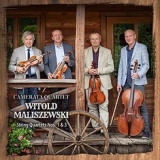Das Camerata Quartet hatte vor einiger Zeit schon das zweite Quartett von Witold Malizewski vorgestellt. Jetzt folgen das erste und das dritte Quartett. Neben einer Violinsonate und einem mit einem zweiten Cello zum Streichquartett besetzten Quintett sind das seine einzigen Werke für Kammermusik.
Der Kopfsatz des Erstwerks, zum Ende seiner Ausbildung gefertigt, zeigt sich mit drängender Unruhe und die Musiker bringen diesen Charakter unverschleiert zur Geltung. Schon hier zeigen wechselnde Metren und die freie harmonische Gestaltung, dass Maliszewski bei seinen Studien bei Glasunow, Ippolitov und Rimsky-Korsakow viel von der gründlichen russischen Schule mitgenommen hat. Im zweiten Satz, Scherzo, folgt eine Lebendigkeit, die Freude, keine Unruhe verströmt. Durchzogen von einer ostinaten Basis biete der Satz Spielfreude pur. Im langsamen Satz, Andante non troppo, werden polnische Einsprengsel eingebunden. Seine harmonische Ausgestaltung zeigt erneut die handwerkliche Kraft des Komponisten. Der vierte Satz, Allegro, bietet dann noch eine gewisse Neuausrichtung im neoklassischen Stil.
Das dritte Quartett, auch mehr als eine halbe Stunde lang, bietet abweichend vom Üblichen, äußerlich nur einen dreisätzigen Aufbau. Dabei gliedert sich der Kopfsatz in eine Introduktion sowie ein Allegro aus Thema und acht Variationen. In diesen kostet Maliszewski nicht nur unterschiedliche Stimmungen und Charaktere aus, sondern auch weit entfernte Modulationen, so dass der Satz trotz seiner fast zwanzig Minuten keine Längen hat. Polyphonie und Elemente eines fugengeprägten Aufbaus geben dem langsamen Satz zusammen mit seiner raffinierten Ausgestaltung dem Satz ein Gepräge von eigener Statur. Maliszewski führt im Finale Komponenten der beiden früheren Sätze wieder ein, baut daraus aber im Endeffekt einen ersterbenden Schluss und fügt nur vorübergehende Kulminationspunkte ein.
Im Jahr vor dem 40. Geburtstag des Camerata Quartetts hebt das Ensemble diese Musik mit seinem passionierten und lebhaften Spiel aus dem Vergessen. Dabei gestalten sie mitreißende Interpretationen, die von klarer struktureller Arbeit am Notentext ebenso geprägt sind wie sie ungebrochene Freude am gemeinsamen Spiel vermitteln. Mit dem an einem Strang ziehenden Zusammenwirken stellen sie sich als edle Quartettvereinigung dar. Mit Witold Maliszewski beleuchten sie einen Komponisten, der um die Wende zum 20. Jahrhundert zu Lebzeiten eine positive Reputation genoss, heute aber außerhalb seiner Heimat unbekannt ist.
The Camerata Quartet already presented Witold Malizewski’s second quartet some time ago. Now the first and third quartets follow, alongside a violin sonata and a quintet scored for string quartet with a second cello, his only works for chamber music.
The first movement of the first work, written at the end of his training, is characterized by urgent restlessness and the musicians bring this character to the fore without concealment. Even here, changing meters and the free harmonic design show that Maliszewski took a lot from the thorough Russian school during his studies with Glazunov, Ippolitov and Rimsky-Korsakov. In the second movement, Scherzo, there is a liveliness that exudes joy, not restlessness. Infused with an ostinato base, the movement offers pure joy of playing. In the slow movement, Andante non troppo, Polish interjections are incorporated. Its harmonic design once again demonstrates the composer’s craftsmanship. The fourth movement, Allegro, then offers a certain new direction in the neoclassical style.
The third quartet, which is also more than half an hour long, deviates from the usual, outwardly only offering a three-movement structure. The first movement is divided into an introduction and an allegro consisting of a theme and eight variations. In these, Maliszewski not only explores different moods and characters, but also distant modulations, so that the movement is not long despite its almost twenty minutes. Polyphony and elements of a fugue-like structure, together with its refined ornamentation, give the slow movement a character of its own. Maliszewski reintroduces components of the two earlier movements in the finale, but ultimately builds a first dying conclusion from them and only adds temporary culmination points.
In the year before the Camerata Quartet’s 40th birthday, the ensemble lifts this music out of oblivion with its passionate and lively playing. In doing so, they create rousing interpretations that are characterized by clear structural work on the musical text as well as conveying unbroken joy in playing together. By pulling together, they present themselves as a noble quartet. With Witold Maliszewski, they shed light on a composer who enjoyed a positive reputation during his lifetime at the turn of the 20th century, but who is now unknown outside his homeland.






















